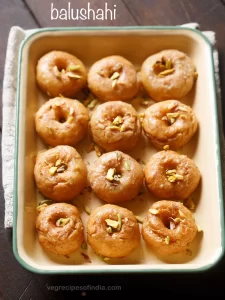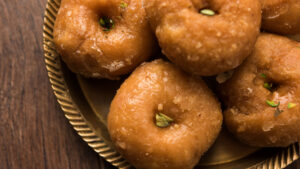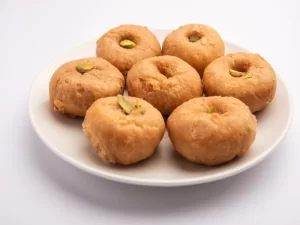What is Balushahi?
When it comes to traditional Indian sweets, one cannot overlook the exquisite and mouthwatering This delectable dessert has a special place in the hearts of sweet lovers across India and beyond. With its flaky texture, sweet syrupy coating, and nutty garnish, shahi is a treat that tantalizes the taste buds and offers a glimpse into India’s rich culinary heritage.
A Sweet History
Balushahi’s origins can be traced back to North India, where it is commonly associated with festivals, celebrations, and special occasions. It has been a beloved sweet for generations and continues to be an integral part of Indian culture and cuisine.
Ingredients
It is made from a handful of simple ingredients, but it’s the craftsmanship and precision in its preparation that make it extraordinary. The primary components include:
- All-purpose flour
- Ghee (clarified butter)
- Yogurt or curd
- Baking soda
- Sugar
- Water
- Cardamom powder
- Saffron strands (for garnish)
Chopped nuts (usually pistachios or almonds)
The Making of Balushahi
- Preparing the Dough: Begin by mixing all-purpose flour, ghee, yogurt, and a pinch of baking soda to form a smooth, firm dough. Let it rest for about 15-20 minutes.
- Shaping the shahi: Pinch off small portions of the dough and roll them into small discs. Create a small dent in the center to give it the classic shahi shape.
- Frying to Perfection: Heat ghee in a deep frying pan, and once it’s hot, lower the flame and carefully add the Balushahi pieces. Fry them until they turn golden brown and crispy.
- Sugar Syrup: In a separate pan, make a sugar syrup by dissolving sugar in water. Add a pinch of cardamom powder and saffron strands for flavor and color. Boil until it reaches a one-string consistency.
- Dip and Garnish: Once this fried, dip it into the hot sugar syrup, making sure it’s coated evenly. Remove and place it on a tray. Garnish with chopped nuts while it’s still sticky.
- Cool and Serve: Allow the Shahi to cool and set for a few hours. Once it has hardened, it’s ready to serve.
Balushahi Variations
While the classic Shahi recipe is delightful, there are regional variations with unique flavors and textures. Some regions use milk instead of yogurt, while others add a touch of cardamom or rose water to the dough for an extra aromatic twist.
Let’s delve deeper into the delightful world of Balushahi:
- Cultural Significance: Balushahi is more than just a dessert; it’s deeply rooted in Indian culture and tradition. It is often prepared during festivals and special occasions, such as Diwali, Holi, weddings, and other celebrations. It symbolizes sweetness, happiness, and the sharing of joy with loved ones.
- Regional Variations: Balushahi is known by different names in various regions of India. In the North, it’s called “Balushahi,” while in the South, it’s known as “Badusha” or “Badhusha.” Each region adds its own unique twist to the recipe, making it a diverse and culturally rich dessert.
- Festival Favorites: During Diwali, the Festival of Lights, Balushahi holds a special place on the dessert table. Families exchange boxes of homemade Balushahi as a gesture of love and goodwill. It’s also a popular choice for offering to deities during prayers and pujas.
- Expertise and Craftsmanship: Making perfect requires skill and precision. The dough must be kneaded to just the right consistency, and frying it demands careful temperature control. Achieving the perfect flaky texture and golden-brown color is an art that is passed down through generations.

- Sweet Syrup: The sugar syrup used to coat is a key element. It not only adds sweetness but also acts as a preservative, allowing the dessert to stay fresh for longer periods. The saffron strands and cardamom powder in the syrup infuse it with a delightful aroma and flavor.
- Balushahi in Other Cuisines: The concept of Balushahi has also made its way into other cuisines. In neighboring countries like Nepal, Bangladesh, and Pakistan, similar sweets are prepared with slight variations in ingredients and preparation methods.
- Modern Twists: While the traditional Balushahi recipe remains timeless, chefs and home cooks often experiment with modern twists. Some may fill the center with flavored creams or chocolate, creating fusion desserts that appeal to contemporary tastes.
- Commercial Availability: While homemade Shahis is cherished, you can also find it in Indian sweet shops and bakeries. It’s available in various sizes, from bite-sized pieces to larger ones, making it accessible to people with different preferences.
- Global Recognition: Thanks to the growing popularity of Indian cuisine worldwide, Balushahi is gaining recognition beyond India’s borders. It’s not uncommon to find on the dessert menus of Indian restaurants in different parts of the world.let’s explore more about Balushahi:
- Homemade Delight: While Balushahi is readily available in sweet shops, there’s a special joy in making it at home. Many families have their secret recipes and techniques, making homemade Balushahi a cherished tradition passed down through generations.
- Serving Styles: Balushahi can be enjoyed in various ways. Some prefer it fresh and warm, right after it’s made, when it’s at its crispiest. Others like it a bit softer and more syrup-soaked after it has rested for a while. You can choose the style that suits your preference.
- Pairing and Presentation: Balushahi is often served with a cup of hot chai (tea) or coffee. Its flaky, sweet goodness pairs wonderfully with the slightly bitter and aromatic flavors of these beverages. When presented, Shahi is often arranged beautifully on a plate, making it as visually appealing as it is delicious.
- Homage in Literature and Arts: It has found its place not only in kitchens but also in literature and arts. It’s mentioned in various Indian poems, stories, and even Bollywood movies, where it’s often used as a symbol of celebration and happiness.
- Dietary Considerations: For those with dietary restrictions, there are recipes for vegan and gluten-free versions of Balushahi, which use plant-based ingredients and gluten-free flours like rice flour or chickpea flour. This allows more people to savor its delightful taste.
- Street Food Favorite: In some parts of India, you can find street vendors selling freshly fried Balushahi. The tantalizing aroma of these sweet treats wafts through the air, drawing people to indulge in this delightful street food.
- Celebratory Sweet: Balushahi is not limited to festivals and weddings. It’s often shared during family gatherings, birthdays, and other joyful occasions. Its presence on the dessert table signifies the importance of the celebration.
- Cultural Exchange: Shahi has not only stayed within India’s borders but has also been shared with other countries through cultural exchanges. Indian communities around the world continue to prepare and share this beloved sweet with their local communities.
- Resilience of Tradition: In the age of modern convenience foods, Balushahi stands as a testament to the resilience of traditional culinary practices. It showcases the value placed on handmade, labor-intensive sweets that have stood the test of time.
- Community Bonding: Preparing often involves a collective effort within families and communities. Multiple hands come together to knead the dough, shape the sweets, and fry them, fostering a sense of togetherness and bonding.
- Personal Touch: Shahi allows for personalization. Some people prefer it sweeter, while others like it less syrupy. You can tailor the sweetness and syrup level to your liking, making it a dessert that suits individual tastes.
- Seasonal Specialties: Shahi, like many Indian sweets, has seasonal variations. During the winter months, especially around Diwali, it’s common to find shahi made with khoya (reduced milk solids), adding a creamy richness to the sweet.
- Storage and Shelf Life: Balushahi has a relatively long shelf life compared to some other Indian sweets. When stored in an airtight container, it can stay fresh for several weeks, making it a convenient and enduring treat for celebrations.
- Balushahi in Other Cultures: Similar sweets to Balushahi can be found in various cultures around the world. For instance, in the Middle East, a dessert called “Zalabia” or “Zalabya” bears a resemblance and is equally beloved.
- Health Consciousness: While Balushahi is undoubtedly delicious, it’s also known for its richness and calorie content due to the ghee and sugar syrup. As people become more health-conscious, there is a trend toward creating lighter versions of Balushahi with reduced sugar and fat content.

- Homage in Art and Decor: Balushahi’s distinct shape and visual appeal often inspire artistic representations. You might find paintings, sculptures, or even decorative items shaped like Balushahi in Indian art and decor.
- Sweet Memories: Many Indians have fond childhood memories associated with Balushahi. It’s a sweet treat that grandparents often share with their grandchildren, passing on the love for this traditional dessert.
- Regional Pride: Different states in India take pride in their unique versions of Balushahi. For example, the North Indian is known for its flakiness, while the South Indian Badusha has a softer texture. This regional diversity adds to the charm of Balushahi.
- Gift of Good Luck: In some Indian cultures, Balushahi is considered a symbol of good luck and prosperity. It’s exchanged during weddings and other auspicious occasions to bring blessings to the couple or the recipient.
- Balushahi Competitions: In some places, Balushahi-making competitions are held during festivals or fairs. Participants showcase their culinary skills and compete to make the best-tasting and most beautifully presented Balushahi.
- Online Recipes and Tutorials: In the age of the internet, there’s a wealth of Balushahi recipes and tutorials available online. This accessibility has made it easier for people around the world to try making this delectable sweet at home.
let’s delve even deeper into the fascinating world of Balushahi:
- Balushahi Festivals: In some regions of India, Balushahi has its own dedicated festivals and fairs. These events celebrate the craftsmanship of making shahi and draw crowds from far and wide to savor this sweet delight.
- Art of Garnishing: It is not just about taste; it’s also about presentation. Skilled sweet makers take great care in garnishing Shahi with finely chopped nuts, saffron strands, or even edible silver or gold foil, elevating its visual appeal.
- Diverse Regional Names: Shahi may be known by different names not only across India but also in various countries. For instance, in Nepal, it’s called “Barfi” (not to be confused with the milk-based sweet also called “Barfi” in India), and in Pakistan, it’s known as “Balushai.”
- Special Occasion Packaging: During festivals and weddings, Balushahi is often beautifully packaged in decorative boxes or trays. These make for elegant gifts, and the packaging itself adds to the sense of festivity.
- Shahi in Popular Culture: Balushahi has made its way into Indian literature, films, and television shows. It’s not uncommon to see characters enjoying a plate in a Bollywood movie, adding a touch of sweetness to the storyline.
- Artisanal Variations: Some artisanal sweet shops take Balushahi to the next level by infusing it with unique flavors. You might come across Balushahi flavored with rose, saffron, or even exotic ingredients like paan (betel leaf).
- Balushahi Challenge: Inspired by food challenges on social media, some enthusiasts attempt to create giant-sized or push the limits of creativity by incorporating unconventional ingredients and toppings.
- Balushahi in Street Food: Beyond traditional sweet shops, It is occasionally found as a street food item in India. Street vendors often prepare it fresh, offering a hot and crispy version that’s hard to resist.
- Global Popularity: As Indian cuisine gains global popularity, it is become a dessert that’s celebrated worldwide. It’s not uncommon to find Balushahi in Indian restaurants in major cities around the globe.

40.Variations in India: Each state in India has its own take on. For example, the Rajasthani version, known as “Mawa Kachori,” is stuffed with khoya and nuts. These regional variations highlight the diversity of flavors and techniques in Indian cuisine.

My partner and I absolutely love your blog and find many
of your post’s to be what precisely I’m looking for.
can you offer guest writers to write content for yourself?
I wouldn’t mind producing a post or elaborating on some of the subjects you write about here.
Again, awesome site!
Hi there, You have done a great job. I’ll certainly digg it and personally recommend to my friends.
I’m sure they will be benefited from this website.
Also visit my blog post kitchen renovation experts
Howdy just wanted to give you a quick heads up. The text
in your post seem to be running off the screen in Opera.
I’m not sure if this is a formatting issue or
something to do with browser compatibility but
I thought I’d post to let you know. The layout look great though!
Hope you get the issue resolved soon. Thanks
Also visit my web page :: خرید بک لینک
плей фортуна казино
i get my art books from barnes and noble that come or amazon, they have some great discount coupons too”
Your method of describing all in this paragraph is actually nice, all be capable of effortlessly know it,
Thanks a lot https://formationmatieresdangereuses.com/cours-de-conduite-de-classe-1/
stromectol otc
Hello, I found your blog in a very new directory of blogs. I don’t learn how your site came up, need to have been a typo. Your blog looks good, have a nice day.
An fascinating discussion will be worth comment. I do believe that you can write regarding this topic, it might become a taboo subject but typically consumers are insufficient to dicuss on such topics. Yet another. Cheers
Hi, Neat post. There’s an issue with your web site in internet explorer, may check this¡K IE nonetheless is the marketplace chief and a good portion of people will miss your fantastic writing because of this problem.
Youre so cool! I dont suppose Ive read anything this way just before. So nice to seek out somebody with a few original thoughts on this subject. realy thanks for beginning this up. this web site is one thing that is needed on the net, someone with some originality. helpful project for bringing something totally new towards the web!
I’m truly enjoying the design and layout of your blog. It’s a very easy on the eyes which makes it much more pleasant for me to come here and visit more often. Did you hire out a designer to create your theme? Superb work!
As soon as I noticed this website I went on reddit to share some of the love with them.
i am always looking for some free stuffs over the internet. there are also some companies which gives free samples. [Reply]
I really liked your article. Thanks.
Perfectly written content material , thanks for entropy.
This is a topic which is near to my heart…
Thank you! Where are your contact details though?
Aw, this became an extremely good post. In thought I have to invest writing like this additionally – taking time and actual effort to make a good article… but what can I say… I procrastinate alot and no indicates manage to go done.
Putin Interview Summary Putin Interview Tucker.
Tucker.